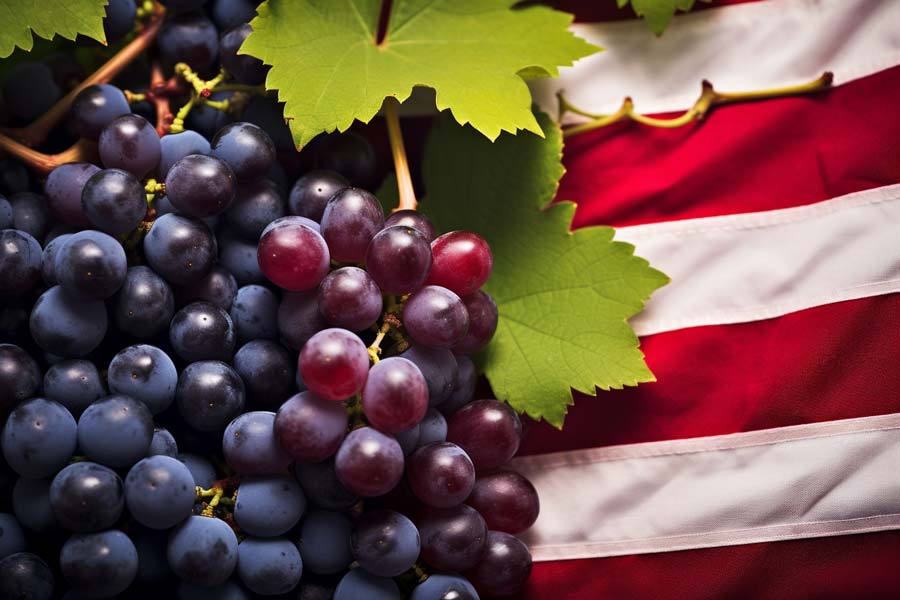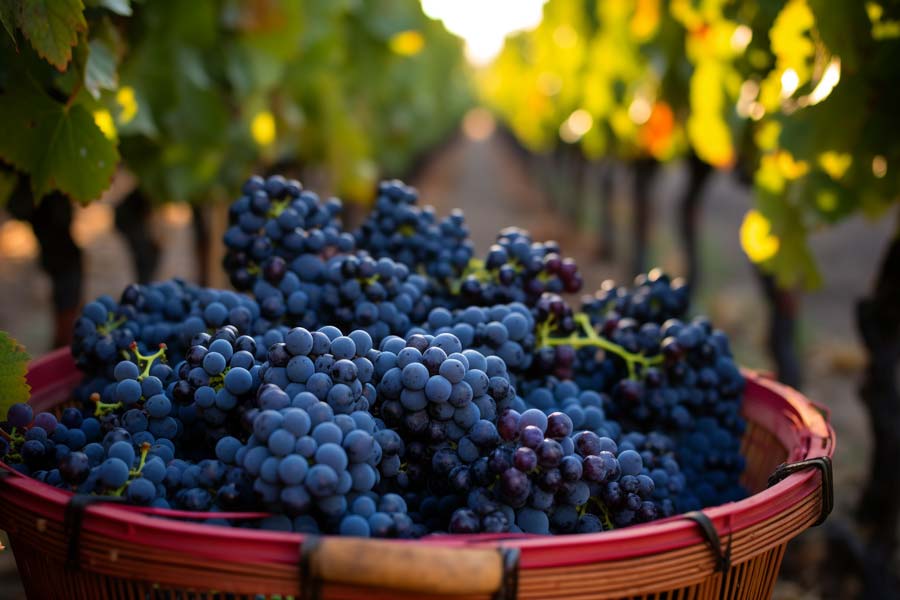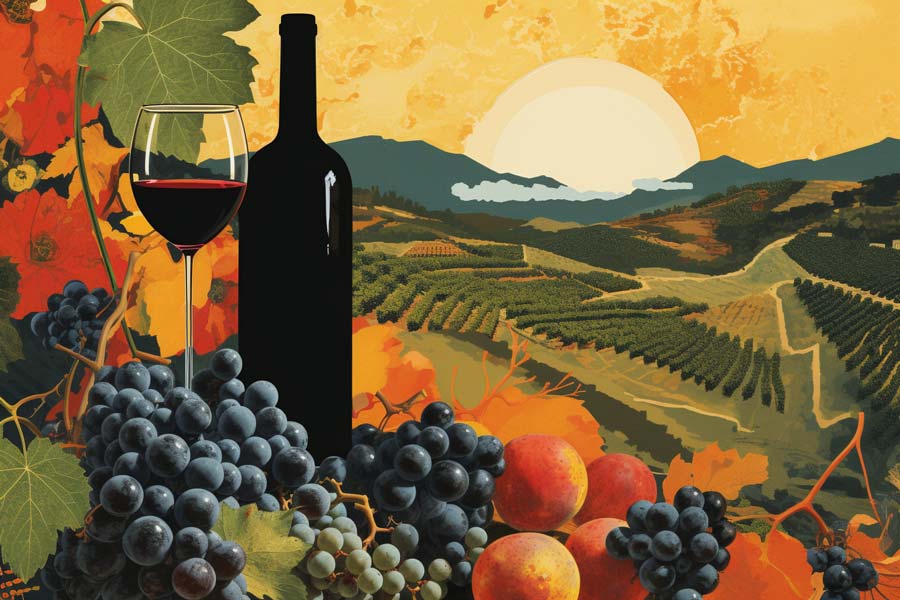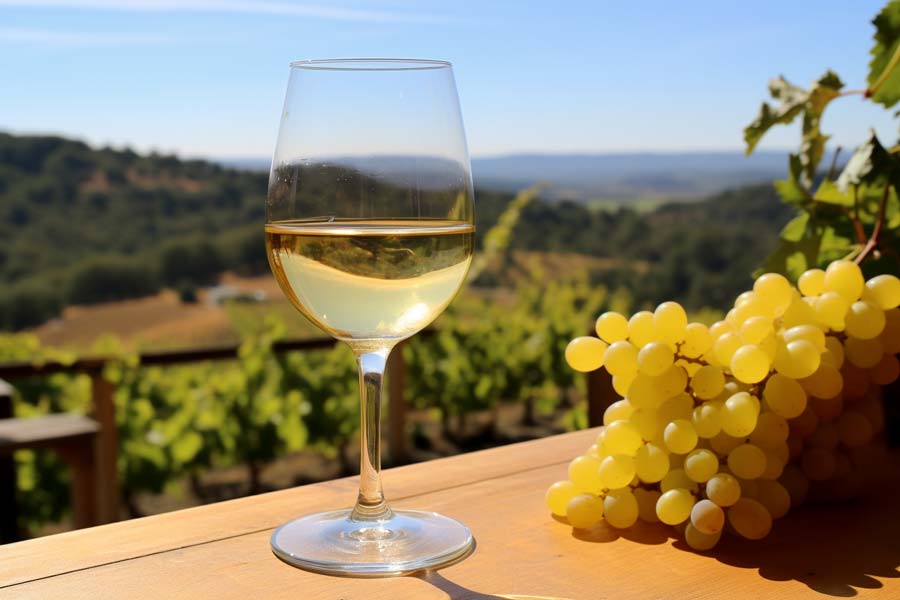Table of Contents
Introduction:
Many wine enthusiasts are familiar with popular American wine grape varieties such as Cabernet Sauvignon, Merlot, and Chardonnay. However, there exists a vast world of lesser-known grapes that have quietly been establishing their own reputation.
Tucked away in tranquil valleys and perched on picturesque hillsides throughout the country, these vineyards hold a treasure trove of hidden gems. Within their boundaries, they cultivate wines that possess equal complexity, refinement, and expressiveness as their more renowned counterparts.
This article takes readers on a captivating journey, exploring and celebrating the top five most underrated American wine grape varieties.
Pour yourself a glass and take a seat as we embark on an exploration of the often overlooked heroes behind American viticulture.
The Rise of American Wine Grape Varieties

Viticulture has shaped America’s agricultural and cultural history, starting with early settlers who planted European vines in the fertile soils of the East Coast. The pioneers further recognized the potential of the vast terrains of the West. Through their efforts, viticulture emerged as a pivotal force that reverberated across time and geography.
Settlements expanded, colonies thrived, and the challenge of producing wines to rival those from the Old World consumed many aspiring American winemakers.
The various climates and diverse terrains across Oregon’s cool coastlines to California’s sun-drenched valleys provided abundant opportunities for grape experimentation. Over the years, through trial and error, specific regions discovered the perfect pairing of certain grape varieties, giving rise to renowned wine-producing areas like Napa Valley and Willamette Valley. However, the ascent of American vineyards wasn’t without its challenges.
In the 1920s, Prohibition dealt a significant blow to the wine industry. Its progress was halted, and many vineyards were forced into ruin. However, amidst the challenges, American winemakers displayed remarkable resilience and determination. The post-Prohibition era witnessed a resurgence in the wine industry as these winemakers explored beyond traditional American wine grape varieties. They ventured into cultivating grape varieties that had yet to establish their presence in the American landscape, despite their popularity in Europe.
Today, the United States has established itself as the fourth-largest wine producer globally, a testament to its remarkable growth and unwavering dedication. While certain American wine grape varieties have gained international acclaim and recognition, others patiently anticipate their turn in the spotlight.
As the exploration deepens, hidden treasures are uncovered. These underrated stars contribute to the rich tapestry of American viticulture, illuminating its essence.
The Underrated American Wine Grape Varieties: An In-depth Exploration
Petite Sirah (Durif): America’s Dark and Robust Secret

The Petite Sirah, scientifically known as Durif, serves as a remarkable testament to America’s profound ability in embracing, nurturing, and amplifying grape varieties from all around the world.
The Durif grape originated in France through the crossbreeding of Peloursin and Syrah grapes. However, its path to recognition truly began when it ventured overseas and found a strong foothold in the diverse soils of America.
In the early 20th century, the Petite Sirah rooted itself firmly in Californian vineyards. Basking under the sun-kissed skies, it thrived and gradually emerged from the shadows of its more popular counterparts. Throughout the years, this varietal gained a renowned reputation for producing wines with exceptional depth and intensity.
The resilience of the Petite Sirah grape, with its natural ability to combat diseases and pests, struck a chord with American winemakers, who were captivated by its unwavering spirit in the face of adversity. This enduring quality further endeared it to local vintners. [
When someone pours a glass of Petite Sirah, they immediately notice its distinctive character, setting it apart from any other wine.
The intense, inky hue of this beverage captures your attention immediately. Its dark purple shade nearly verges on black, providing a glimpse into the opulent flavors it holds. As you take a sip, its complexity reveals itself layer by layer – bold notes of ripe blackberry, succulent blueberry, and juicy plum intertwine harmoniously with nuances of velvety dark chocolate, fragrant black tea, and a subtle hint of black pepper.
With its tannic backbone and full-bodied nature, this wine is known for its remarkable structure. It is highly suitable for aging, making it an exceptional choice.
If you’re seeking an enchanting encounter with the full-bodied charm of Petite Sirah, set your sights on esteemed vineyards like Stags’ Leap Winery and Parducci Wine Cellars nestled in California’s scenic landscapes.
These establishments consistently showcase their expertise in cultivating the full potential of grapes. Through their skill, they produce exceptional bottles that not only capture the rich characteristics of the grapes but also embody the essence of American terroir where they thrive.
Counoise: America’s Spirited Expression of an Old World Gem
Counoise had humble origins in the Rhône Valley of France. However, its transplantation to American soils marked a captivating evolution in its narrative.
American winemakers initially brought over this grape for its role in the renowned Châteauneuf-du-Pape blends. However, they soon recognized its potential as a standalone varietal.
The grape’s transition from a supporting role in French blends to the forefront of American vineyards showcases both the adaptable nature of the grape itself and the innovative spirit of U.S. vintners. Over time, Counoise found favor in regions that mirrored its original habitat in Rhône, with California and Washington State leading the way in cultivating and propagating this distinctive varietal.
A glass of Counoise is akin to an aromatic journey.
The bright ruby-red color of the wine entices, revealing an inviting aroma filled with the essence of cherries and raspberries. Delicate notes of freshly cracked white pepper add intrigue, while a touch of floral elegance completes the sensory experience.
In terms of taste, Counoise is considered medium-bodied with a lively acidity that enhances its compatibility with various food options. This adaptability opens up a wide range of pairing opportunities, spanning from herb-roasted chicken to more delicate options like seared tuna or beet salads.
For those eager to explore the finest offerings of Counoise, regions such as Paso Robles in California truly shine. In this captivating wine destination, Tablas Creek Vineyard and Bonny Doon Vineyard stand out by showcasing the remarkable potential of this grape variety. Their exceptional wines serve as a testament to Counoise’s growing prominence in the rich tapestry of American wine varietals.
Tannat: America’s Robust Rediscovery

Tannat, originally a key grape variety in the wine regions of Southwestern France, particularly Madiran, embarked on an extraordinary voyage to the New World. The grape found its initial successes in Uruguay, making a significant impact there. However, its journey of evolution did not end in Uruguay alone.
In their constant pursuit of diversity and excellence, American vineyards warmly embraced the introduction of Tannat into their repertoire.
The grape, with its bold tannins and inherent richness, discovered a new home in the diverse climates of the United States. The regions of California and Virginia became especially favorable for this transition. This migration not only added depth to America’s viticultural landscape but also expanded Tannat’s reach from being a beloved regional choice in France to garnering international recognition within the wine community.
In the United States, Tannat has undergone a transformative journey. Its role has shifted from being used for blending purposes to producing standalone, captivating red wines that leave a lasting impression on the palate.
A bottle of American Tannat promises an intense sensory experience.
Aromatically, Tannat presents a captivating blend of dark fruits such as blackberries and plums. These flavors intertwine with hints of tobacco, dark chocolate, and occasionally a subtle smoky undertone.
The robust tannic structure of this wine demands attention, making decanting a beneficial step for those who want to fully savor its intricate layers. This boldness complements hearty dishes such as grilled steaks, lamb, or even spicy barbecue exceptionally well.
Vineyards across the United States have embraced the Tannat grape with great enthusiasm. Notably, Bending Branch Winery in Texas, Tablas Creek Vineyard in California, and Chrysalis Vineyards in Virginia play a pivotal role as ambassadors for this exceptional variety. Their dedication ensures that Tannat’s rich legacy continues to thrive and captivate wine enthusiasts throughout America.
Albariño: A Spanish Gem in American Terroir

From the lush, green valleys of Galicia in Northwest Spain, known as the stellar Rías Baixas wine region, Albariño has journeyed across vast oceans to take root in the fertile soil of America.
The American journey of Albariño is a fascinating tale of admiration and intrigue. Originally introduced to California in the late 20th century, winegrowers quickly recognized its potential to thrive in specific microclimates reminiscent of its Spanish homeland. While still relatively limited in acreage compared to other renowned varietals, Albariño has swiftly gained a reputation for itself, captivating enthusiasts with its unique characteristics. It has firmly established a solid footing, particularly in regions of California and Oregon.
With just a sip of Albariño, one is whisked away to the picturesque coastal landscapes. The aroma of the salty sea breeze intertwines harmoniously with zesty hints of fresh citrus, crisp green apple, and succulent stone
A white wine of remarkable character, it gracefully dances on the palate with vibrant acidity, leaving a refreshing and vivid sensation.
The Albariño wine is known for its complex flavor profile which includes underlying notes of almond, honeysuckle, and occasionally a subtle hint of wet granite. This intricate combination provides a nuanced complexity that is truly irresistible. As a result, Albariño pairs exceptionally well with seafood dishes, especially oysters, scallops, and cev
When searching for the ultimate American Albariño experience, a journey to esteemed regions like Edna Valley and Paso Robles in California becomes necessary. Notable vineyards such as Tangent in Edna Valley or Bodega de Edgar in Paso Robles truly shine as exceptional representatives, skillfully blending Spanish tradition with innovative American techniques to produce exquisite Albariño wines.
Carménère: The Lost Grape Finds Home in America
Carménère, a variety thought to be lost forever, has made a remarkable comeback in the New World. Its story is as fascinating as its flavors.
Carménère, originally from Bordeaux, France, faced near extinction during the 19th-century phylloxera epidemic and remained thought to be extinct for years. However, in a remarkable turn of events, it was rediscovered in Chile during the 1990s. Surprisingly, it had been mistakenly grown as Merlot.
The grape didn’t just rejuvenate on South American shores. It ventured north, embraced by American vintners who saw its potential and planted it in regions like California and Washington State. Today, this once-forgotten varietal is making waves in the American wine scene. Vineyards proudly produce bottles that not only hold a rich history but also offer a distinctive taste that captivates the senses.
In the vast realm of red wines, there exists a medium to full-bodied variety. Its distinctive character showcases the essence of ripe red fruits, with notes reminiscent of succulent raspberries and cherries. These harmonize harmoniously with subtle nuances of bell pepper, earthiness, and on occasion, even decadent
The wine is highly sought after by connoisseurs due to its velvety tannins and lushness. When it comes to pairing options, Carménère beautifully complements dishes such as roasted meats, hearty stews, and aged cheeses.
Yearning for an authentic American Carménère experience? Look no further than top-notch vineyards in two prominent regions. In Washington’s Walla Walla Valley, Reininger Winery has gained renown for delicately crafted Carménère wines that boast finesse and depth. Meanwhile, in California’s Sierra Foothills region, Viña Moda stands out for their innovative approach to this varietal that captivates both critics and enthusiasts alike.
The Impact of Lesser-Known American Grape Varieties on the Wine Market
In an industry often dominated by well-known celebrities and familiar wine grape varieties that capture everyone’s attention, the introduction and ascent of lesser-known grape varieties have injected a delightful energy into the wine market.
These lesser-known grape varieties, including Carménère and Albariño, offer enthusiasts a unique tasting experience while also extending an invitation to a wider audience to embark on exciting wine adventures.
These stories of resurrection, migration, and evolution deeply resonate with wine consumers who seek authenticity and a meaningful connection. Moreover, they provide vineyards with a strategic advantage by allowing producers to diversify their portfolios and cater to niche markets that crave distinctive flavors and compelling narratives.
These grapes are gaining traction and leaving a mark on the wine industry. Their distinct profiles not only enrich the tapestry of wine but also challenge vintners to push boundaries and improve their craft. Beyond just the bottle, their influence extends to reshaping market trends and driving a movement towards exploring and appreciating the vast world of viticulture.
Conclusion
The American wine scene is well-known for its vibrant and diverse selection, which owes much of its richness to the often overlooked wine grape varieties. These underrated grapes contribute to a more complete and intricate portrayal of the country’s wine landscape.
These lesser-known grapes embody the innovative and exploratory spirit that characterizes American winemaking. Each variety, from the bold Petite Sirah to the subtly nuanced notes of Carménère, recounts stories of resilience, adaptability, and an unwavering pursuit of excellence. They serve as a testament to the industry’s commitment to pushing boundaries and championing unexpected discoveries.
These varieties of wine extend an invitation to both enthusiasts and casual drinkers. They offer a unique tasting journey, introducing flavors that challenge the palate. Moreover, they provide an opportunity to indulge in captivating stories that span across continents and centuries.
As the American wine landscape continues to evolve, these often overlooked gems serve as a vibrant reminder of the endless possibilities that hide within each bottle.
The next time an individual finds themselves perusing the wine aisles or scanning a restaurant’s wine list, they should consider taking a leap of faith.
The path less traveled beckons, inviting one to embrace the allure of the unknown and raise a glass to the diverse tapestry of American wine grape varieties awaiting celebration.
FAQs
What grape is native to the United States?
The most well-known native American grape varieties is the Vitis labrusca, commonly referred to as the Concord grape. It differs from European varieties like Cabernet Sauvignon, Merlot, and Chardonnay. The Concord grape is used for making grape jelly, juice, and sometimes wine – particularly kosher wine. It has a unique “foxy” flavor that sets it apart from European wine grapes. While there are various other native grape species in different parts of the U.S., none are as famous as the Concord.
What is the most popular wine varietal in the US?
Chardonnay, the white wine grape, maintains its position as the most popular wine varietal in the U.S. when it comes to volume sales. This versatile grape has captured the hearts of American wine enthusiasts due to its ability to produce a wide array of wines that cater to various preferences. From California’s rich and buttery oaked versions to the crisper and lighter unoaked styles, Chardonnay offers something for every palate. However, it’s important to stay informed about changing tastes and trends in the wine industry by consulting updated statistics or market reports.
What is the most planted wine grape in the USA?
In the United States, Chardonnay takes the lead as the most widely cultivated wine grape. It thrives particularly in California, which stands as the nation’s top wine-producing state. The expansive Chardonnay vineyards span across more acres compared to any other grape variety. This immense popularity stems from its diverse range of styles, catering to the tastes of American wine enthusiasts who appreciate both crisp and unoaked varieties, as well as indulging in rich and buttery options.
What are American bunch grapes?
American bunch grapes are a type of grape native to North America. They differ from European wine grapes (Vitis vinifera), which are commonly used for producing wines like Cabernet Sauvignon, Chardonnay, and Merlot.